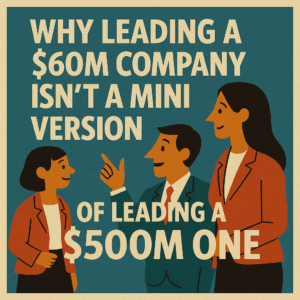Small and Mid-Sized Business Insights: Why Leading Managers Isn't the Same as Leading Executives
The org charts may look the same—but leadership is completely different.

For a CEO, leading a sub-$100M business is not a junior version of leading a $500M one – it’s a completely different animal altogether. The difference isn’t just in the simplicity of smaller companies-fewer product lines, leaner teams, and more straightforward go-to-market strategies – it’s in the kind of leadership that drives success.
The biggest shift I’ve observed? Who I’m actually leading.
In a $500M+ company, I’m leading executives.
In a $30M company, I’m leading managers.
At first glance, this might seem like a subtle distinction. After all, both groups often carry the same titles-VP of Sales, CFO, Head of Ops. But don’t be fooled. The behaviors, expectations, and leadership needs of these individuals couldn’t be more different.
Same Titles, Different Roles
In a mid-sized business, those leaders aren’t simply overseeing functions-they’re in the work.
The Head of Ops isn’t just reading dashboards-they’re fixing the broken processes behind them. The VP of Sales isn’t just managing a pipeline-they’re closing the biggest deals. The Marketing leader isn’t approving creative-they’re building campaigns and writing copy.
This hands-on approach leads to deep accountability and strong collaboration. Everyone owns their piece of the puzzle, and there’s very little overlap or politicking. There’s no time to posture when the work has to get done.
In Large Companies, Everyone Wants to Be CEO
In contrast, the leadership team in a large company is made up of professionals who could likely be CEOs themselves. And that dynamic introduces real complexity.
There’s more overlap in roles. More competition for influence. More resistance to alignment.
And a whole lot more internal politics.
In those environments, the CEO spends far more time navigating executives than making strategic decisions. No one designs it that way on purpose-but it’s a outcome when leadership is filled with ambitious operators with overlapping experience and competing priorities.
The irony? In large companies, customer outcomes are often three steps removed from the boardroom. You’re talking about growth, but you’re managing people managing people managing people.
Mid-Sized Companies Run on Action
This is why I prefer running mid-sized businesses. The work is tangible. The team is closer to the customer. The meetings are about real issues-things that impact revenue, cost, and morale right now.
As CEO, I’m not a referee – I’m leading a team of engaged, capable doers who are more focused on progress than politics. That’s not only more effective-it’s more energizing.
Hiring for the Mid-Sized Company
On paper, hiring a seasoned leader from a $500M or $1B+ company to run your $60M business looks like a great idea. The logic goes: If they can run a massive business, surely they can lead something smaller. But that logic breaks down fast in practice.
The leadership skills that drive success in large companies don’t always transfer to mid-sized businesses. Big-company executives are used to leveraging resources and their leadership style is built for navigating complexity and managing other executives. Their leadership is rarely designed for hands-on problem solving in a fast-moving, resource-constrained environment.
I’ve seen this firsthand: many big-company execs are excited to take the reins of a smaller company. But once the honeymoon ends, many stall. Others implode. Not because they aren’t capable-but because the context is wrong.
The smarter strategy? Hire for the stage the company is at-not the one it might reach someday.
If you’re running a $30M or $60M company, you need a leader who thrives in that environment. Someone who’s operated at that level, solved the kind of problems you’re facing, and knows how to lead from the front. Someone who’s scrappy, resilient, and tuned to lead doers-not delegators.
Later, when the company grows and divisions become self-contained, then it’s time to bring in the executive who knows how to lead leaders of leaders, manage investor relations, and steer a complex, layered organization.
Stage-appropriate leadership isn’t a “nice-to-have”-it’s a requirement.
Final Thought
If you’re a CEO, founder, or investor and you think the difference between leading a $50M company and a $500M one is not just a matter of scale. The roles may share titles. The org charts may look similar. But the lived reality is completely different.
Personally, I’ll take the mid-sized company every time. Less politics. More action. Clearer outcomes. And a leadership model built for speed and accountability – I’m just built this way, a doer
Next Steps:
If you’re building or leading a mid-sized company and want help scaling it with the right people and the right systems-without losing momentum-let’s talk.
Let’s Talk
I help fast-growing businesses create systems that make bold ideas executable—without chaos.
✔️ Fractional COO and CMO support
✔️ Leadership routines that drive performance
✔️ Cross-functional alignment and accountability
Learn More: http://marc-drucker.com
Connect on LinkedIn: linkedin.com/in/marc-drucker
Schedule Time to Connect: https://bit.ly/MarcDrucker-Calendly